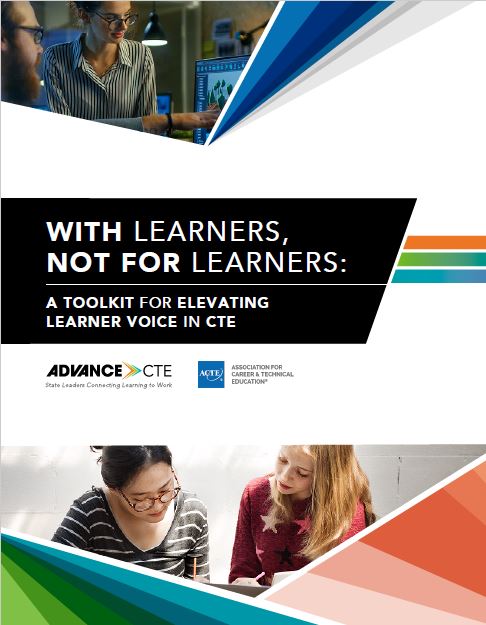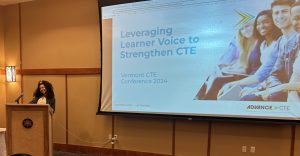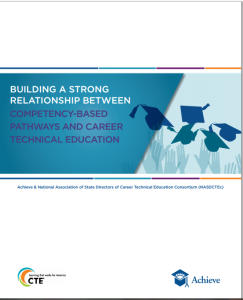Vermont’s Career Technical Education (CTE) leaders are continually advancing their efforts to ensure equity, meaningful learner engagement, and real-world readiness across the state’s career pathways. Senior Policy Associate Haley Wing led two impactful sessions at Vermont’s 2024 annual conference in Jay Peak, Vermont—a small ski town near the Canadian border that highlighted two Advance CTE resources—Using the Achieving Inclusive CTE Goal-Setting Tool and Leveraging Learner Voice to Strengthen CTE.
These sessions offered state leaders actionable insights and practical tools to take their work to the next level, showcasing how Advance CTE’s resources can help align CTE systems with learners’ needs and priorities. Throughout the conference, discussions, workshops, and panels built upon these themes, reflecting Vermont’s commitment to equity, career exploration, and fostering learner success.
This blog highlights how Vermont leaders use these tools to elevate their work, celebrates the fantastic progress across the state, and outlines promising practices for others to consider.
Session 1: Leveraging Learner Voice to Strengthen CTE
 Meaningful learner engagement is critical to program improvement, equity, and inclusion across CTE programs, policies, and opportunities. Leaders across Vermont are well aware of the value of leveraging learner voice in CTE. Leaders across the conference elevated existing practices and opportunities to improve programs and learning environments and meet learners’ diverse needs using their feedback, input, and leadership.
Meaningful learner engagement is critical to program improvement, equity, and inclusion across CTE programs, policies, and opportunities. Leaders across Vermont are well aware of the value of leveraging learner voice in CTE. Leaders across the conference elevated existing practices and opportunities to improve programs and learning environments and meet learners’ diverse needs using their feedback, input, and leadership.
While the session elevated findings from Advance CTE’s Leveraging Learner Voice to Strengthen CTE technical assistance cohort built upon Advance CTE’s With Learners, Not For Learners: Learner Voice Toolkit, promising practices, and methods of meaningful learner engagement emerged from the plenary session:
- Accounting for different dimensions of diversity is critical to meaningful learner engagement. Throughout the session, leaders recognized their geographic location and the demographics typical of their state. While racial diversity is not always enabled, other equity dimensions should be accounted for to ensure learners engage in real-world work experiences to prepare them for the workforce.
- Progress over perfection; the work builds over time: CTE Center Directors across the state participated in an interactive version of the Assessments for Engaging CTE Learners from the Learner Voice Toolkit (page 35 in the toolkit). Through audience examples, it became clear that many directors are already actively fostering meaningful learner engagement. Specific actions include:
- Collaborating with learners to gather feedback on programs and make improvements;
- Integrating learner voice into decisionmaking meetings that impact their CTE experiences;
- Initiating discussions with CTE instructors to deepen and expand learner engagement across CTE opportunities.
 Session 2: Achieving Inclusive CTE Goal-Setting Through Data
Session 2: Achieving Inclusive CTE Goal-Setting Through Data
Incorporating and leveraging data is a critical component of CTE program improvement, especially with a focus on equity and inclusion. Advance CTE is committed to supporting leaders in accomplishing and actualizing the valuable practice of leveraging data and goal-setting to meet equity goals aligned with Carl D. Perkins Career and Technical Education Act (Perkins V) tools. Trainings like the Opportunity Gap Analysis Workshop and the Achieving Inclusive CTE Goal-Setting Tool are examples of resources for CTE leaders to support this work and development.
Leaders across Vermont are expanding their use of CTE data in earnest with the Achieving Inclusive CTE Goal-Setting Tool. During this session, CTE Center Directors discussed opportunities to leverage the tool across their centers, different ways to interpret and read the tool’s analyses, and strategies to support others in leveraging it for inclusivity and equity.
Promising Practices and Next Steps
Both sessions demonstrated that Vermont’s CTE leaders are deeply committed to fostering inclusive, equitable environments that place learners at the center. By focusing on learner voice and data-driven goal-setting, the state creates pathways for learners to succeed, regardless of background or circumstances. Leaders are actively strengthening programs and cultivating relationships that prepare learners for the workforce and future challenges.
Key Takeaways
- Equity through Action: Both sessions underscored the importance of recognizing learners’ diversity and taking actionable steps to ensure their voices shape CTE experiences. Whether through feedback loops, targeted improvements, or inclusive decisionmaking, learners are increasingly seen as co-creators of their success.
- Data as a Catalyst for Equity: Leveraging tools like the Achieving Inclusive CTE Goal-Setting Tool allows Vermont’s CTE leaders to transform data into impactful action. By identifying and addressing opportunity gaps, leaders can drive more equitable outcomes across all CTE programs, aligning with the state’s commitment to equity as outlined in Perkins V.
As Vermont’s CTE community prioritizes equity and learner engagement, the collective focus on continuous improvement will drive meaningful progress. By putting learners at the forefront and using data to guide their efforts, Vermont’s CTE leaders are setting a powerful example of how to build more inclusive and responsive programs that prepare all learners for success.
Get Involved
The conference was a reminder that advancing CTE and making it more inclusive is a continual process. As Vermont’s leaders continue to exchange ideas and collaborate, the future of CTE in the state looks promising. With learner voice guiding program development and data illuminating areas for growth, Vermont’s CTE programs are well-positioned to meet the evolving needs of both learners and the workforce.
 To learn more about Advance CTE’s resources, supports, technical assistance and/or speaking opportunities, please see this page on the Advance CTE website.
To learn more about Advance CTE’s resources, supports, technical assistance and/or speaking opportunities, please see this page on the Advance CTE website.





 This post interviews Community College of Vermont’s Director of Prior Learning Assessment, Melissa DeBlois for insights on the need for this resource and how communicating CPL is realized at the institution and learner level.
This post interviews Community College of Vermont’s Director of Prior Learning Assessment, Melissa DeBlois for insights on the need for this resource and how communicating CPL is realized at the institution and learner level. Secretary Cardona Set to Testify Next Week
Secretary Cardona Set to Testify Next Week All of this engagement culminated in a day-long interactive strategic planning workshop in Burlington, Vermont on June 18. Advance CTE’s Deputy Executive Director, Kate Kreamer, and I led and facilitated the workshop, which included not just state CTE staff, but around 30 representatives from a range of stakeholder groups, including local CTE programs, postsecondary institutions, state legislators, industry partners and workforce development. During the workshop, stakeholders examined the data on perceptions of CTE in Vermont and drafted a series of goals and strategies designed to help learners succeed within the state of Vermont. We guided them through a series of exercises to help them understand the needs of learners as well as the needs of other stakeholders and pushed them to work with each other and take ownership over these goals and their role in helping Vermont achieve them.
All of this engagement culminated in a day-long interactive strategic planning workshop in Burlington, Vermont on June 18. Advance CTE’s Deputy Executive Director, Kate Kreamer, and I led and facilitated the workshop, which included not just state CTE staff, but around 30 representatives from a range of stakeholder groups, including local CTE programs, postsecondary institutions, state legislators, industry partners and workforce development. During the workshop, stakeholders examined the data on perceptions of CTE in Vermont and drafted a series of goals and strategies designed to help learners succeed within the state of Vermont. We guided them through a series of exercises to help them understand the needs of learners as well as the needs of other stakeholders and pushed them to work with each other and take ownership over these goals and their role in helping Vermont achieve them.  The demand for Bachelor’s degrees may be
The demand for Bachelor’s degrees may be  In Vermont, Governor Phil Scott announced the launch of a new initiative called
In Vermont, Governor Phil Scott announced the launch of a new initiative called 